|
Breeds of Cattle and Buffalo
Cattle Breeds
| Indigenous dairy breeds of cattle |
| 1. Gir |
|
-
This breed is otherwise called as Bhadawari, Desan, Gujarati, Kathiawari, Sorthi, and Surati.
-
Originated in Gir forests of South Kathiawar in Gujarat also found in Maharashtra and adjacent Rajasthan.
-
Basic colours of skin are white with dark red or chocolate-brown patches or sometimes black or purely red.
-
Horns are peculiarly curved, giving a ‘half moon’ appearance.
-
Milk yield ranges from 1200-1800 kgs per lactation.
-
This bread is known for its hardiness and disease resistance
|
 |
| |
2. Red Sindhi |
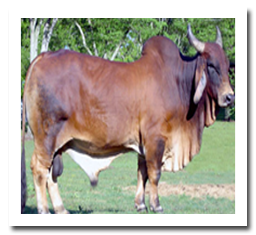 |
- This breed is otherwise called as Red Karachi and Sindhi and Mahi.
- Originated in Karachi and Hyderabad (Pakistan) regions of undivided India and also reared in certain organized farms in our country.
- Colour is red with shades varying from dark red to light, strips of white.
- Milk yield ranges from 1250 to 1800 kgs per lactation.
- Bullocks despite lethargic and slow can be used for road and field work.
|
| 3. Sahiwal |
|
- Originated in Montgomery region of undivided India.
- This breed otherwise known as Lola (loose skin), Lambi Bar, Montgomery, Multani, Teli.
- Best indigenous dairy breed.
- Reddish dun or pale red in colour, sometimes flashed with white patches.
- Heavy breed with symmetrical body having loose skin.
- The average milk yield of this breed is between 1400 and 2500 kgs per lactation.
|
 |
|

| Indigenous Draught breeds of cattle |
| |
1. Hallikar |
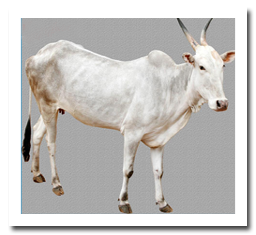
|
- Originated from the former princely state of Vijayanagarm, presently part of Karnataka.
- The colour is grey or dark grey.
- Compact, muscular and medium size animal with prominent forehead, long horns and strong legs.
- The breed is best known for its draught capacity and especially for its trotting ability.
|
| 2. Amritmahal |
|
- Originated in Hassan, Chikmagalur and Chitradurga district of Karnataka.
- Amiritmahals are grey cattle but their shade varies from almost white to near black.
- The muzzle, feat and tail are usually black.
- Horns are long and end in sharp black points
|
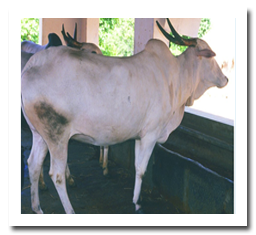 |
| |
3. Khillari |
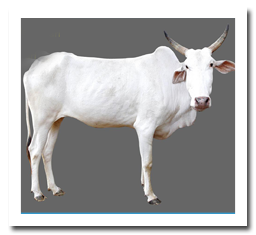 |
-
Originated from Sholapur and Sitapur districts of Maharashtra.
-
Closely resembles Hallikar breed.
-
Grey-white in colour.
-
Long horns turn forwards in a peculiar fashion. The horns are generally black, sometimes pinkish.
-
Bullocks are fast and powerful.
|
| 4. Kangayam |
|
- Also known as kongu and konganad.
- Originated in Kangayam, Dharapuram, Perundurai, Erode, Bhavani and part of Gobichettipalayam taluk of Erode and Coimbatore district.
- Bulls are grey with dark colour in hump, fore and hind quarters.
- The horns are spread apart, nearly straight with a slight curve backwards.
- Cows are grey or white.
- The eyes are dark and prominent with black rings around them.
- Moderate size with compact bodies.
|
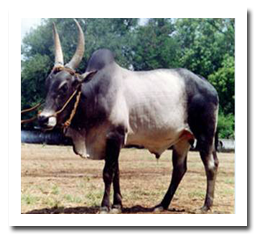 |
| |
5. Bargur |
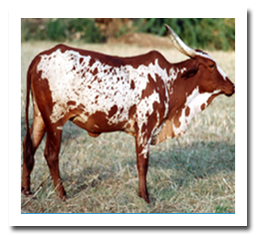
|
- Found around Bargur hills in Bhavani taluk of Erode district in Tamilnadu.
- Developed for work in uneven hilly terrains.
- Generally brown colour with white markings.
- Animals are well built, compact and medium in size.
- Known for their speed and endurance in trotting.
- Cautious in behaviour and tends to remain away from strangers.
|
| 6. Umblachery |
|
- It is otherwise called as Jathi madu, Mottai madu, Molai madu, Therkathi madu.
- Originated inThanjavur, Thiruvarur and Nagappattinam districts of Tamil Nadu.
- Suitable for wet ploughing and known for their strength and sturdiness.
- Umblachery calves are generally red or brown at birth with all the characteristic white marking on the face, on limbs and tail.
- The legs have white markings below the hocks like socks.
- The practice of dehorning of bullocks is peculiar in Umblachery cattle.
|
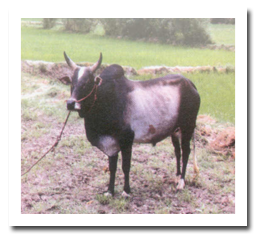 |
| |
7. Pulikulam |
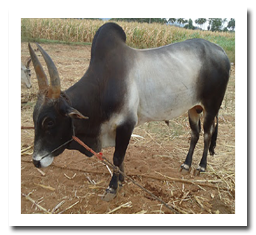 |
- This breed is commonly seen in cumbum valley of Madurai district in Tamil Nadu.
- Also known as Jallikattu madu, kidai madu, sentharai.
- Small in size, usually grey or dark grey in colour.
- Well- developed hump.
- Mainly used for penning in the field.
- Useful for ploughing.
- Presence of reddish or brownish spots in muzzle, eyes, switch and back is the characteristic feature of this breed.
- Typical backward curving horns of likeMysore type cattle.
- Breeds are active, useful draught animals but not fast trotter
|
| 8. Alambadi |
|
- Originated from Alambadi of Dharmapuri district in Tamilnadu.
- Grey or dark grey in colour.
- White markings will be seen in forehead, limb and tail.
- Horns are backward curving like Mysore cattle.
- Resembles Hallikar and also known as Betas.
- It is useful in ploughing
|
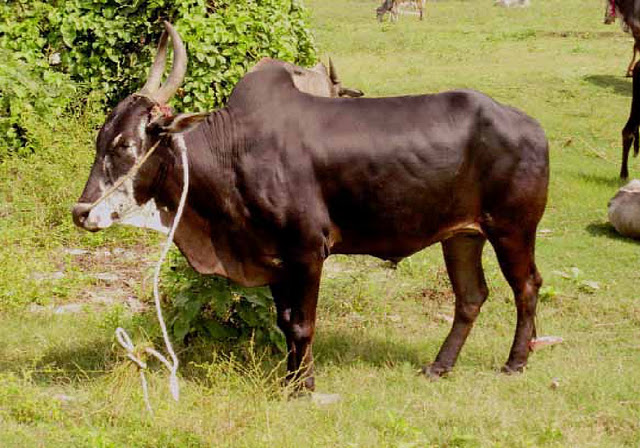 |

| Indigenous Dual purpose breeds of Cattle |
| |
1. Tharparkar |
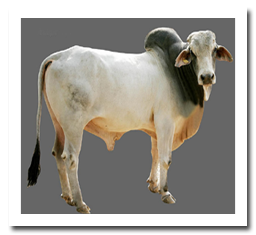 |
- Originated in Tharparkar district (Pakistan) of undivided India and also found in Rajasthan.
- Otherwise known as White Sindhi, Gray Sindhi and Thari.
- They are medium sized, compact and have lyre-shaped horn.
- Body colour is white or light grey.
- The bullocks are quite suitable for ploughing and casting and the cows yield 1800 to 2600 kgs of milk per lactation.
|
| 2. Hariana |
|
- It was originated from Rohtak, Hisar, Jind and Gurgaon districts of Haryana and also popular in Punjab, UP and parts of MP.
- Horns are small.
- The bullocks are powerful work animals.
- Hariana cows are fair milkers yielding 600 to 800 kg of milk per lactation.
|
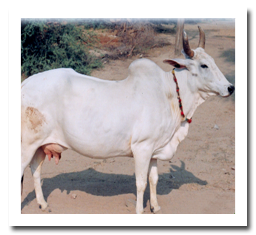 |
| |
3. Kankrej |
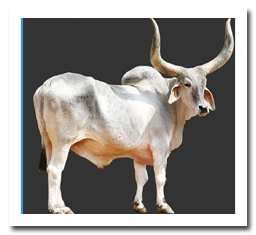 |
- It is otherwise called as Wadad or Waged, Wadhiar.
- Originated from Southeast Rann of Kutch of Gujarat and adjoining Rajasthan (Barmer and Jodhpur district).
- The horns are lyre-shaped.
- Colour of the animal varies from silver-grey to iron-grey or steel black.
- The gait of Kankrej is peculiar called as 1 ¼ paces (sawai chal).
- Kankrej is valued for fast, powerful, draught cattle. Useful in ploughing and carting.
- The cows are good milkers, yielding about 1400 kgs per lactation.
|
| 4. Ongole |
|
- Otherwise known as Nellore.
- Home tract is Ongole taluk in Guntur district of Andhra Pradesh.
- Large muscular breed with a well developed hump.
- Suitable for heavy draught work.
- White or light grey in colour.
- Average milk yield is 1000 kgs per lactation.
|
 |
| |
5.Krishna Valley |
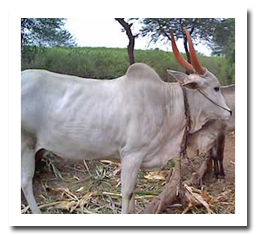 |
- Originated from black cotton soil of the water shed of the river Krishna in Karnataka and also found in border districts of Maharastra.
- Animals are large, having a massive frame with deep, loosely built short body.
- Tail almost reaches the ground.
- Generally grey white in colour with a darker shade on fore quarters and hind quarters in male. Adults females are more whitish in appearance.
- The bullocks are powerful animals useful for slow ploughing, and valued for their good working qualities.
- The average yield is about 900 kgs per lactation.
|
| 6. Deoni |
|
- This breed otherwise known as Dongerpati, Dongari, Wannera, Waghyd, Balankya, Shevera.
- Originated in Western Andra Pradesh and also found in Marathwada region of Maharashtra state and adjoining part of Karnataka.
- Body colour is usually spotted black and white.
- Milk yield ranges from 636 to 1230 kgs per lactation.
- Caving interval average is 447 days.
- Bullocks are suitable for heavy cultivation.
|
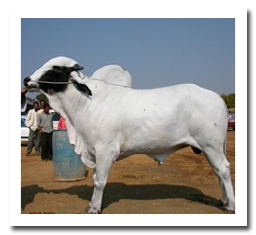 |

| Exotic dairy breeds of cattle |
| |
1. Jersey |
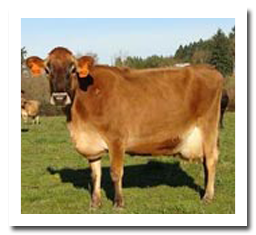 |
- Originated from Jersey Island, U.K.
- Smallest of the dairy types of cattle.
- In India this breed has accliamatized well and is widely used in cross breeding with indigenous cows.
- The typical colour of Jersey cattle is reddish fawn.
- Dished forehead; compact and angular body.
- Economical producers of milk with 4.5% fat.
- Average milk yield is 4500 kgs per lactation.
|
| 2. Holstein Friesian |
|
- originated from the northern parts of Netherlands, especially in the province of Friesland.
- Largest dairy breed and ruggedly built is shape and possess large udder.
- Breeds have typical marking of black and white that make them easily distinguishable.
- The average milk production of cow is 6000 to 7000 kgs per lactation.
|
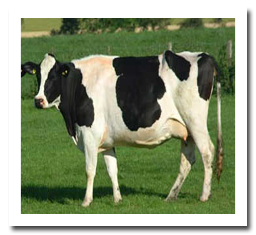 |
| |
3. Brown Swiss |
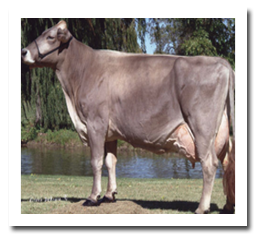 |
- The mountainous region of Switzerland is the place of origin of Brown Swiss breed.
- Breeds are rugged in nature and good milk production.
- Average milk yield is 5000 kgs per lactation.
- The Karan Swiss is the excellent crossbred cattle obtained by crossing this breed with Sahiwal cattle at NDRI, Karnal.
|
| 4. Red Dane |
|
- Orginated in Denmark.
- Body colour of this Danish breed is red, reddish brown or even dark brown.
- It is also a heavy breed;
- The lactation yield of Red Dane cattle varies from 3000 to 4000 kgs
|
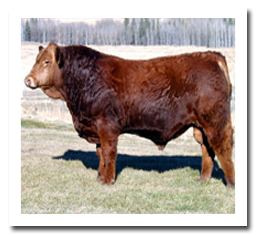 |
| |
5. Ayrshire |
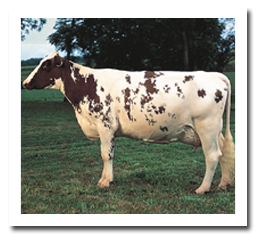
|
- Origin is Ayrshire in Scotland and considered as most beautiful dairy breed. These are very active animals but hard to manage.
- They do not produce as much milk or butter fat (only 4%) as some of the other dairy breeds.
- The breed was also known as Dunlop cattle or Cunningham cattle
|
| 6. Guernsey |
|
- Originated from Small island of Guernsey in France.
- Cherry red to brown in colour. Mahagony and white is a variation in colour.
- The milk has a golden colour due to an exceptionally high content of beta carotene
- Guernsey cows produce around 6000 kgs per lactation.
- The Guernsey cow has many notable advantages for the dairy farmer over other breeds includes high efficiency of milk production, low incidence of calving difficulty and longevity.
|
 |

| Cross bred - Dairy Cattle |
| |
1. Jersey cross |
 |
- Jersey crosses are produced by upgrading/ cross breeding the non descript / Indigenous breeds of cows with Jersey breed semen.
- Jersey crosses are suitable dairy animals for tropical plains of our country.
- They are medium sized, have better heat tolerance than other exotic crosses and well adapted to our climate.
- Depending on the milk production potential of our indigenous cows, the Jersey crosses may show 2 to 3 fold increase in milk yield in the first generation.
|
| 2. Holstein Friesian cross |
|
- The HF crosses are more suitable for temperture climatic regions like hilly areas as they are less tolerant to heat.
- Less resistance to tropical diseases than Jersey crosses.
- Although the milk yield is higher in HF crosses the fat per cent is less.
|
|

Buffalo Breeds
| Indigenous Buffalo breeds |
| |
1. Murrah |
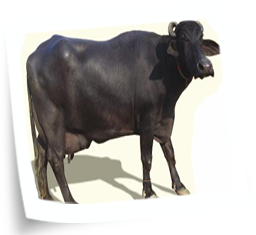 |
- Most important breed of buffaloes whose home is Rohtak, Hisar and Sind of Haryana, Nabha and Patiala districts of Punjab and southern parts of Delhi state.
- Otherwise called as Delhi, Kundi and Kali.
- The colour is usually jet black with white markings on tail and face and extremities sometimes found.
- Tightly curved horn is an important character of this breed.
- Most efficient milk and butter fat producers in India.
- Butter fat content is 7.83%. Average lactation yield is varying from 1500 to 2500 kgs per lactation.
- Also used for the grading up of inferior local buffaloes.
|
| 2. Surti |
|
- Also known as Deccani, Gujarati, Talabda, Charator and Nadiadi.
- The breeding tract of this breed is Kaira and Baroda district of Gujarat.
- Coat colour varies from rusty brown to silver-grey.
- The horns are sickle shaped, moderately long and flat.
- The peculiarity of the breed is two white collars, one round the jaw and the other at the brisket region
- The milk yield ranges from 1000 to 1300 kgs per lactation.
- The peculiarity of this breed is very high fat percentage in milk (8-12per cent).
|
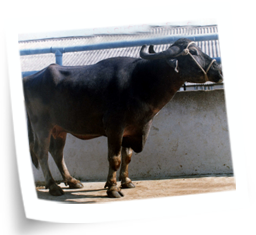 |
| |
3. Jaffrabadi |
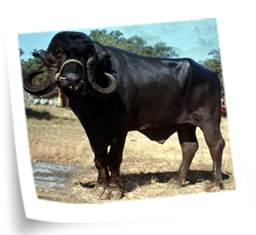 |
- The breeding tract of this breed is Gir forests, Kutch and Jamnagar districts of Gujarat.
- This is the heaviest Indian breed of buffalo.
- The horns are heavy, inclined to droop at each side of the neck and then turning up at point (drooping horns).
- The udder is well developed with funnel shaped teats.
- The average milk yield is 1000 to 1200 kgs per lactation.
- The bullocks are heavy and used for ploughing and carting.
- These animals are mostly maintained by traditional breeders called Maldharis, who are nomads.
|
| 4. Bhadawari |
|
- Home tract of this breed is Agra and Etawah district of Uttar Pradesh and Gwalior district of Madhya Pradesh.
- Medium sized buffalo.
- The body is usually light or copper coloured is a peculiarity of this breed. Eye lids are generally copper or light brown colour.
- Two white lines ‘Chevron’ are present at the lower side of the neck similar to that of Surti buffaloes.
- The average milk yield is 800 to 1000 kgs per lactation.
- The bullocks are good draught animal with high heat tolerance.
- The fat content of milk varies from 6 to 12.5 per cent. This breed is an efficient converter of coarse feed into butterfat and is known for its high butter fat content.
|
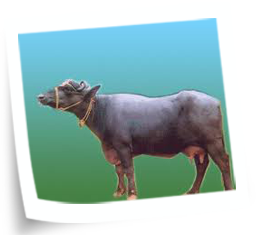 |
| |
5. Nili Ravi |
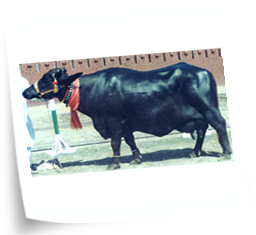 |
- originated around the river Ravi.
- This breed is found in Sutlej valley in Ferozpur district of Punjab and in the Sahiwal (Pakistan) of undivided India.
- The peculiarity of the breed is the wall eyes.
- Head is small, elongated, bulging at top and depressed between eyes.
- Horns are very small and tightly coiled.
- Bullocks are good for heavy trotting work.
- The milk yield is 1500-1850 kgs per lactation.
|
| 6. Mehsana |
|
- Mehsana is a dairy breed of buffalo found in Mehsana, Sabarkanda and Banaskanta districts in Gujarat and adjoining Maharashtra state.
- The breed is evolved out of crossbreeding between the Surti and the Murrah.
- Body is longer than Murrah but limbs are lighter.
- The horns are less curved than in Murrah and are irregular.
- Bullocks are good for heavy work.
- The milk yield is 1200-1500 kgs per lactation.
|
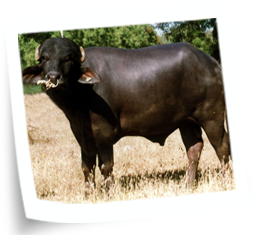 |
| |
7. Nagpuri |
 |
- This breed is also called as Elitchpuri or Barari.
- The breeding tract of this breed is Nagpur, Akola and Amrawati districts of Maharashtra.
- These are black coloured animal with white patches on face, legs and tail. The horns are long, flat and curved, bending backward on each side of the back. (Swaord shaped horns).
- The bullocks can be used for heavy work.
- The milk yield ranges from 700 to 1200 kgs per lactation.
|
| 8. Toda |
|
- This buffalo is named after an ancient tribe, Toda of Nilgiris Hills of south India and it is a semi-wild breed.
- The predominate coat colours are fawn and ash-grey.
- Thick hair coat is found all over the body.
- They are gregarious in nature.
- The body is long and deep and the chest is deep. The legs are short and strong.
- The horns are set wide apart curving inward, outward and forward forming a characteristic crescent shape.
- The average milk yield is 500 kgs per lactation with high fat content of 8%.
|
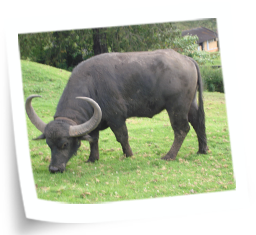 |
 |
































